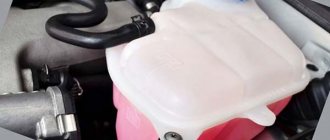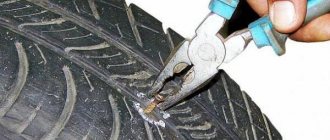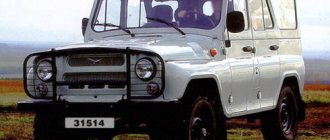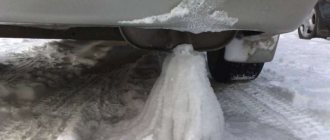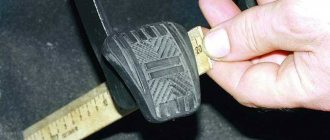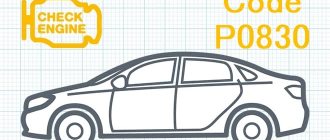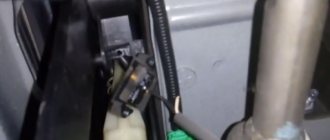When choosing a car, buyers pay special attention to ergonomics and ease of driving. Controls include not only the steering wheel, but also the gearbox and the pedals used in the car. When placing pedals in a car, all automakers adhere to generally accepted standards.
It is also interesting that on identical machines their number may differ. This directly depends on which gearbox is provided in a particular configuration. On manuals there are more control levers, on cars with automatic transmission there are fewer of them, since the need for one of the pedals disappears.
The first cars were equipped exclusively with mechanical transmissions, which made it possible to control the behavior of the car and its speed. Drivers accustomed to manual transmissions note that the mechanics allow you to fully feel the car, thereby feeling like you are in charge.
Then came automatic transmissions. Working with them has become much easier. Yes, many may argue that mechanics are the basis, and only such a box makes it possible to get the most out of the car. Currently, it is not necessary to know how to operate a manual transmission if you buy a car with an automatic transmission.
Location
The pedals are arranged in the same order. Regardless of whether the transmission is manual or automatic. Automatic machines, robots and CVTs have two pedals instead of three. Because there is no need to disengage the clutch.
An interesting fact: in right-hand drive cars that are driven in Japan and the UK, and sometimes found here, the position of the pedals coincides with the left-hand drive cars we are used to. And not in a mirror image, as some might imagine.
What to check before leaving
The first thing you need to check before leaving for the city is that you have a driver’s license and an MTPL policy with you. Even experienced drivers often forget these documents at home, which causes embarrassment when stopped by a traffic police officer.
When inspecting the car you need to check:
- Brakes;
- Parking lights;
- Headlights, taillights;
- Steering;
- Driver's side windshield wiper.
According to Russian laws, driving is prohibited even to the place of repair if these elements are faulty. It would be a good idea to check the engine oil level, coolant level, and washer fluid level. They also check the tire pressure, especially before a long journey.
Car with manual transmission
Cars equipped with manual transmission have three pedals. The arrangement of the mechanic's pedals is as follows.
- Clutch . The clutch is controlled by the pedal on the far left. Disengaging the clutch makes switching between gears easier and reduces the load on the gearbox parts.
- Brake. The pedal in the middle causes the car to slow down and is called a brake. Pressing it engages the car's braking system, preventing the wheels from rotating. At the same time, the speed decreases until it stops.
- Gas. The farthest pedal on the right side is gas. Pressing it causes increased engine operation and acceleration of the car. The acceleration speed directly depends on the pressing force. It is recommended to apply pressure gradually and smoothly.
What pedals are there in the car, and what is the order in which they are located?
When choosing a car, buyers pay special attention to ergonomics and ease of driving. Controls include not only the steering wheel, but also the gearbox and the pedals used in the car. When placing pedals in a car, all automakers adhere to generally accepted standards.
It is also interesting that on identical machines their number may differ. This directly depends on which gearbox is provided in a particular configuration. On manuals there are more control levers, on cars with automatic transmission there are fewer of them, since the need for one of the pedals disappears.
The first cars were equipped exclusively with mechanical transmissions, which made it possible to control the behavior of the car and its speed. Drivers accustomed to manual transmissions note that the mechanics allow you to fully feel the car, thereby feeling like you are in charge.
Then came automatic transmissions. Working with them has become much easier. Yes, many may argue that mechanics are the basis, and only such a box makes it possible to get the most out of the car. Currently, it is not necessary to know how to operate a manual transmission if you buy a car with an automatic transmission.
Automatic machine
There are only two pedals in an automatic car, because disengaging the clutch is not required. Gears change automatically.
- Brake. The pedal on the far left will be the brake. It is larger than in a manual car.
- Gas. The pedal on the right is gas.
The location of the automatic pedals is the same as that of the manual.
First trip to the city after receiving your license
Beginners always look forward to leaving for the city after receiving their license with great anxiety. Before this, an experienced instructor sat in the passenger seat, always ready to provide backup and, if necessary, to stop the car. Now you have to rely only on yourself, plus bear responsibility for the passengers.
To prevent your first trip from turning into torture, use these tips for beginners.
- Don’t be afraid to ask questions to the seller: cars have their own characteristics, the location of controls depends on the brand, and there are many things you may not know.
- Don’t show others how dashingly you can race: having driven a car for the first time, you don’t know how quickly it can stop and how it behaves in motion. Ride for a while slowly, measuredly, noticing the reaction of the transport to your actions.
- If possible, avoid busy highways on the first day.
- Don't forget to look in your rearview mirrors, especially before you start maneuvering.
- Try not to turn on the radio. Contrary to all the advice of a beginner, music does not calm, but distracts.
Remember: now the most dangerous road users for you are not cars, as before, but pedestrians and cyclists. They appear in front of the car unexpectedly, behave unpredictably, many of them only heard about traffic rules at school and only out of the blue. When approaching a pedestrian crossing, slow down, or better yet, immediately put your foot on the brake pedal (but do not press it). So, in the event of an unexpected appearance of a pedestrian or cyclist, you can gain a fraction of a second, and therefore precious meters of braking distance.
Mechanical pedal operation
In a car with a manual transmission, turn off the handbrake. Then start the engine. To do this, turn the ignition key in the lock until it stops. After this, press the clutch and switch to first gear.
After which the clutch is released and the car begins to move. Next, the gas is smoothly squeezed out, and as it accelerates, gears are changed after pressing the clutch.
Gears must be changed both when accelerating and when decelerating. The stages are switched in order so as not to break the box and not throw the engine out of rhythm.
Gas, brake, clutch - must work as one team, otherwise there will be jerks, jerking of the car, and the engine will stall. When switching gears incorrectly or inconsistently, the gearbox crunches.
Three true friends
Now is the time to get acquainted with manual pedals. On the left is the clutch, in the middle is the brake, and on the right is the gas. I will say that this arrangement is the same for both right-hand drive and left-hand drive cars. Therefore, you will have to remember it once, even if you subsequently need to change to another car with a manual transmission.
In a manual car, the clutch is responsible for:
Make sure you fully depress the clutch. To do this, simply press on it with your left foot. You can only change gears when the clutch is fully depressed.
How did I do it? At first I pressed the pedals one at a time, then randomly, trying to remember and get used to their location. I pressed the gas and brake with my right foot alternately. At the very beginning, the main thing is to remember the correct location and not get confused.
Working with pedals
How to use the clutch pedal on a manual transmission? Try pressing the clutch to the floor and shifting the gearshift lever to one of the speed positions. Once you have engaged the gear, slowly release the pedal. No sudden jerks or sudden movements. I did this several times in a row until I remembered how I felt.
First of all, make sure that your car's brakes are working properly. Training on faulty brakes is a waste of time and will not yield any results. And learning to drive such a car is quite risky.
It is very important to remember and feel what the pedal should be, its hardness, in order to notice a malfunction in time. If she:
This indicates a malfunction. If you experience similar sensations when pressing, then this is a serious reason to contact a car service center.
The brake pedal in a manual car is located in the center. To activate it, press it with your right foot. To brake, you must press the brake and clutch at the same time when you turn on the speed. From my own experience, I will say that the clutch must be pressed a certain fraction of a second faster than the brake.
The gas pedal is located on the right. By pressing or releasing it with your right foot, you give a command to the car's fuel system to increase or decrease the supply of the fuel mixture. As a result of such actions, your car will gain or lose speed. The harder you press the gas, the higher the speed will be. The video above describes everything in detail once again – it’s worth watching.
The location of the pedals on the “mechanics” can be seen in the photo above. So you will understand what's what. I am sure that after just a few lessons you will be able to easily drive your car.
Source
Operation of automatic pedals
Automation control is much easier. There is no need to constantly disengage the clutch; the gears switch themselves in the required sequence using special clutches.
The lever only turns on the “D” mode for moving forward. Or “R”, for reversing the car. There may also be modes “P” - for long-term parking and “N” - corresponding to neutral gear for manual transmission.
Pressing the gas after starting the engine causes the car to move in the desired direction. The force applied to the brake pedal is transmitted to the braking system and safety systems such as ABS. The braking device is much more complex than a manual one.
Starting the engine at low temperatures
If you jump into a car in cold weather and immediately squeeze the gas, the car with an automatic transmission will kick, push and possibly not move anywhere. In order for the wheels to receive torque from the engine, you need to “start” the machine.
When the temperature changes, the liquid in the box changes its properties, and it needs to warm up in order to work at full strength. To do this, after starting the engine, you need to wait until the speed drops a little and the engine warms up. Then press the brake and move the automatic selector through all positions.
The lower the temperature outside, the longer the box will warm up: at -20℃ it will take 5 - 10 minutes.
What to do after manipulating the selector:
- Press the brake. Set mode "D".
- When a push occurs - a signal to engage the gear, you can release your foot.
- Smoothly depress the gas 1/3 and drive 300 meters.
During this time, the oil will go through several cycles through the automatic transmission and will be completely restored.
Which foot to press
The key to safe driving is pressing the pedals correctly with the right foot.
Important rule: You should always press the clutch pedal with your left foot, and brake and gas only with your right foot.
If we conditionally divide the foot into three segments, this will allow us to more accurately explain the rule:
- the front part of the foot, as the most sensitive, presses the gas;
- the middle part, harder and stronger, on the brake or clutch;
- the heel is not used, this part is the least sensitive, and it is extremely inconvenient to work with.
Attention: shoes are an important part of pedal control. To operate the car, you need comfortable shoes in which you can “feel” the pedals well. The shoes are tight and loose on the foot.
The soft sole of some running shoes reduces this sensation, which prevents you from pressing the pedals with the necessary effort and increases the risk of getting into an accident.
You cannot drive a car in shoes with long heels (this applies to women). The cause of the accident may be that your heel gets under the brake pedal, which prevents you from pressing it all the way.
There are those who like to argue about the possibility of pressing the brake with the left foot in cars equipped with automatic transmission, since there are two pedals. It's a matter of convenience and driver habit. If you are used to braking with your right hand, it will be difficult to relearn, it is better to leave it as is, so as not to mix up the pedals.
Functional Features
Having studied the features of the location of the pedals in cars with a manual transmission, it will not be difficult to finally remember where each is. Each of you understands that the pedals in the car play a certain role. Everyone has their own strictly assigned function. And they need to be taken into account when getting behind the wheel.
Let us remind you how the pedals in any car go from left to right on the driver’s side:
In an automatic transmission, everything goes exactly the same way, but only with the condition that there is no clutch in this sequence.
To better understand the functional features, you need to consider all the pedals separately.
Clutch
It's easy to remember where the clutch lever is located in your car. It is important to take into account that on all cars they are always in the same place. Car companies cannot place the clutch on the right or in the middle.
Now let’s talk more specifically about why such a control lever in a car as a clutch pedal is needed. Responsible for the connection between the gearbox and the engine, as well as disconnection as necessary. If the pedal is not touched, the engine will be connected to the gearbox, that is, at this time the clutch is considered to be engaged.
When the control lever is pressed to the floor, disengagement occurs and therefore the clutch is disengaged. In order for the car to start moving, the driver must turn the clutch back on. And to do this, simply release the pedal.
If you take into account the design, everything happens as follows:
This happens quickly and cyclically with every gear shift on a manual transmission.
When operating a car with a manual transmission, that is, if there is a clutch in the form of a pedal, you must adhere to some rules:
It is the clutch that makes driving cars with manual transmission more difficult when compared with automatic transmission. But you get used to everything and you can learn everything.
Having the skills to control a manual transmission with a clutch pedal, switching to an automatic transmission will not be difficult. But if you learned to drive an automatic transmission, and then had to switch to a manual transmission, you can feel as if you were behind the wheel for the first time.
Brake
You already know where the brake pedal should be located in the car. If in a car with a manual transmission, then in the middle, and if with an automatic transmission, then on the left.
By pressing this control lever, the driver thereby transfers the load to the amplifier. It creates additional force on the master brake cylinder installed in the car. By releasing the pedal, the return spring allows you to return the element to its original position.
There is nothing complicated in the design of this component. This is a lever with a special platform for the foot on the bottom side. There are also a couple of holes near the top end. Through one hole passes a pin that allows the pedal to move back and forth in a confined space.
The second hole is needed to connect the vacuum booster to the plug. If there is no booster, then there is a connection to the master cylinder of the brake system. To create a reliable and movable connection, metal pins are used.
When the driver presses this pedal, any car is designed to automatically turn on the brake lights located behind the car.
It is also an accelerator or accelerator pedal. Here you should also understand what the accelerator pedal in a car is and how it works.
The element is designed to give the car acceleration. This is achieved by opening the throttle valve and increasing the amount of fuel entering the combustion chamber. The harder the driver presses the control lever, the more air-fuel mixture enters the combustion chamber. It is only important to take into account the fact that traditional and electronic pedals can be installed on cars.
If this is a mechanical standard pedal, then the design includes a cable drive for the damper. When the driver squeezes the element, the cable opens the throttle valve. The opening occurs exactly at the angle at which the cable rod was pressed.
With an electronic pedal, things are a little different. When you press the control lever to accelerate, a special sensor reads information about the angle of pressure and transmits it to the motor control unit. The block itself determines at what angle the throttle valve should be opened, after which it transmits the corresponding command to the actuator, that is, the drive.
With a manual transmission, the driver has to create optimal interaction between the clutch and the gas. These two pedals are closely related to each other. In cars with automatic transmissions, everything is much simpler. Of the two pedals, only gas remains. And the clutch adjusts automatically.
It is recommended to clarify in advance which gas pedal is installed in the car you are purchasing. Many talk about the undeniable advantages of technology development, that is, the electronic accelerator pedal is considered the obvious favorite.
But in such designs there are too many intermediate elements between the pedal itself and the throttle valve. The electronics take over determining how far to open the damper. And this is not always liked by drivers who are accustomed to independently determining how much acceleration they need. Therefore, they give preference to the classic and time-tested mechanical cable drive.
Electronic pedals are being developed to make vehicles more environmentally friendly. They help reduce emissions and harmful emissions. But at the same time, they do not allow the driver to completely control the situation. Whether this is good or bad, everyone decides for themselves.
Controlling the gas is easy. But even here there are some peculiarities. Therefore, when preparing to drive your new vehicle, it is recommended to practice a little to get used to the response of the accelerator. To do this, start the engine and apply the parking brake with the transmission in neutral. In most cases, this pedal has minimal resistance, which is why even with light pressure the car can jerk forward sharply, creating active acceleration. It's no wonder that driving instructors used to put a raw egg under the gas pedal. Thus, they forced drivers to be extremely careful and apply measured pressure on the pedal.
Pressing two pedals
Such misfires happen to both amateur and professional drivers - they press the gas and brake at the same time. What are the possible consequences:
- when you simultaneously press the gas and brake on a manual, it breaks first the clutch discs (the linings burn and crumble, the metal turns blue and loses strength), then the gearbox gears;
- for an automatic it’s generally fatal, the torque converter burns out almost immediately;
- Some modern machines and robotic boxes have protection against such clicks. They react to such a situation as if they were applying a brake;
- a similar reaction is intended for racing cars. This allows riders to brake without taking their foot off the gas.
Shifting to first gear
Hold the clutch and shift the lever to first gear. Usually this is a movement to the left and up from yourself.
Now further, while holding the clutch pedal, switch the gearbox lever to first speed, that is, to the left and away from you.
Just don't drop the clutch, otherwise the car will stall! Don't worry friends, you will definitely learn this over time!

